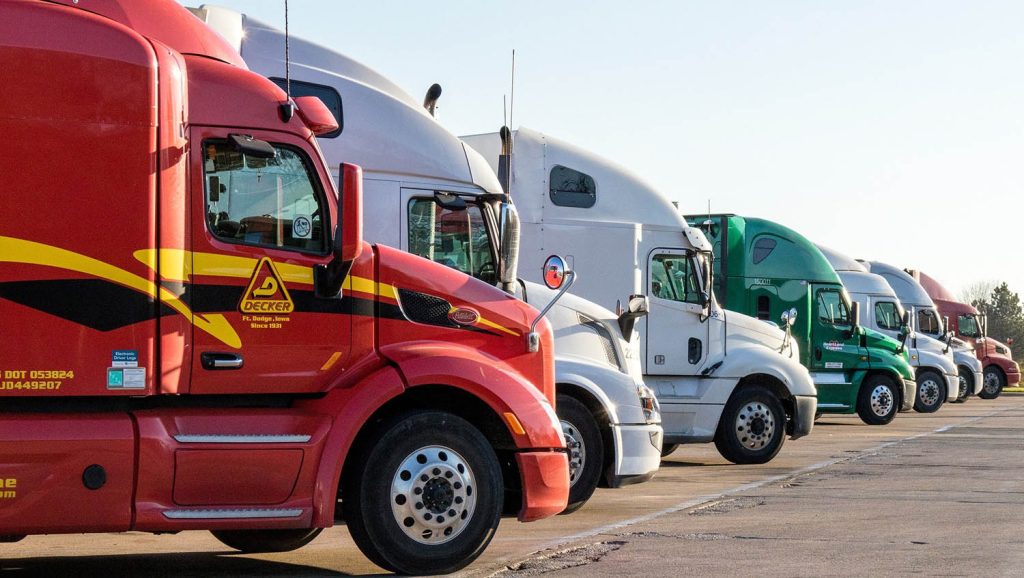Table of Contents
Because accidents involving large trucks and buses have become a serious national problem, the federal government organized the Federal Motor Carrier Safety Administration (FMCSA) under the U.S. Department of Transportation (DOT) in 2000. The legislation authorizing this was the Motor Carrier Safety Improvement Act of 1999.
There are now numerous rules regarding the operation of such vehicles. The stated goal is to reduce the number of injuries and fatalities involving large trucks and buses. These rules concern a truck driver’s use of drugs and alcohol, traffic violations, properly securing loads, maintenance of equipment, inspections, handling hazardous materials, rest periods, hours they are allowed to drive, and many other subjects.
A commercial vehicle is defined by the FMCSA as:
- a vehicle involved with transporting cargo or people between states or;
- the vehicle must weigh 10,001 pounds or more (gross vehicle weight) or;
- the vehicle is used or made to transport more than eight people for compensation (including the driver) or;
- the vehicle is made and used to transport fifteen or more people (including the driver) and is not used to transport people for compensation or;
- the vehicle hauls material designated as hazardous by the DOT and requires placarding
Consider the latest numbers from the FMCSA. In the calendar year 2014 (the last full year that data was available), more than 150,000 accidents were reported that involved large trucks and buses. These resulted in 4,384 deaths and more than 87,000 injuries. This situation represents a serious problem.
Employers of truck drivers are required by the FMCSA to have an education program in place for the drivers concerning drug and alcohol abuse. Supervisors and drivers must be provided with drug and alcohol training materials. There must be a written policy, and the employer must provide that to each driver. They must be aware of the Return-To-Duty process that has to be followed if there is a positive breath or blood test of one of their drivers. According to federal regulations, they must receive one hour of training on alcohol misuse and one hour of training on controlled substance abuse. Drivers must be tested with a negative result before being hired to operate a commercial vehicle.
Rules and Regulations on Alcohol and Drugs
Post-accident testing may be required following a commercial truck accident on a public highway. This must be completed in certain ways to ensure the results will be legally admissible in any subsequent hearings, and it also means that they could be useful to you in a civil trial if you know how to obtain them. Results could show the presence of prescription medicine, prohibited drugs, or alcohol, which would help make your case stronger. The specific requirements when such a test would be required depend on such factors as:
- Did someone die?
- Is someone seriously injured?
- Is the truck driver required to have a Commercial Driver’s License?
- Was the truck driver given a ticket for a moving violation?
- Was one of the vehicles involved disabled and towed?
An alcohol test must be completed within two hours of the accident, while a drug test must occur within thirty-two hours. If the driver refuses the test, that person will be prohibited from driving an employer’s commercial vehicle. If the employer is unable to have the test administered, he must document why. Alcohol testing can be performed by a blood test or a breath test, so even if the driver is injured the test can still be completed. A urine test is used for a drug test. Either test would be failed if it shows a blood alcohol concentration of 0.04 or more.
If any step is not completed correctly, they could be in violation of federal regulations, which ultimately could make your own case stronger and make them subject to civil penalties for noncompliance.
Cellphones and Logbooks
Truck drivers are prohibited from using cell phones or any handheld device to communicate, which includes texting. Specifically, the commercial driver is not allowed to access web pages, send or retrieve a message, or use a device that involves pushing more than one button to activate or terminate a call. Some states allow drivers to use cell phones, but it does not matter to interstate commercial truck drivers because they are specifically prohibited from using them unless they use a speaker or earpiece with one-button activation.
Violation of these rules can be proven in different ways. For example, the police report may have it documented, the driver might admit to it, a witness may have seen this action before or during the accident, or telephone records may show it.
Research has shown that a commercial driver who texts is more than twenty-three times more likely to be involved in an accident, a near accident, or an unintentional lane change, than other drivers. Those drivers who texted were found to have looked away from the road for a little less than five seconds, but when traveling at 55 miles per hour, this would mean the driver had traveled about the length of a football field without seeing the road.
Those who use cell phones while driving were found to be six times more likely to be involved in such a safety-related incident as someone who did not use such a phone.
Rules on Rest Periods
Federal requirements for a commercial driver involve recording their status each 24-hour period, which means they must show whether they are driving, off duty, in the sleeper berth, or on duty but not driving. Drivers must also record their location (city, state, along with the time and date) every time their status changes. Additional details are required to be collected, which include the date, total miles driven on the date, the description and identifying information of his vehicle, the name and certification of the driver, the office address, co-driver’s name, total hours, and the shipping document number or the name of the shipper and the items hauled.
Truck drivers hauling property are allowed to drive no more than eleven hours out of a 14-hour time period and then only after having a 10-hour rest period. Logbooks must also have entries verified to guard against false entries by the driver in an attempt to conceal missed rest stops or spending too much time on the road.
Commercial truck drivers must pass a medical examination. It is important that it be established that the driver has no medical conditions that would negatively impact driving a big rig or bus. For example, a diabetic, a person with a heart condition, or other health challenges could be a real problem behind the wheel.
Some common causes of accidents include driver error, under or oversteering, fatigue and inexperience.
Traffic violations committed by drivers include disregarding traffic lights, running stop signs, driving recklessly, speeding and improper lane changes. Such violations will be documented at the time of the initial accident investigation.
As with logbooks, black boxes could have their data altered or erased, which is why they must be collected as soon as possible and preserved. Maintenance records of the truck itself could also be falsified.
Truck Rules
Trucks are larger, weigh more and are taller than cars, tending to make them more unstable vehicles with a higher center of gravity. This makes them have more of a tendency to roll over. These vehicles need more distance to stop because they are heavier, and even more distance is needed if they are carrying a heavy load. They can also jackknife easily, causing them to block two or more lanes of traffic. These vehicles are much longer than others, so blind spots are a problem. These can cause the truck driver not to see a vehicle that is attempting to make a legal pass.
Trucks have limits on the weight they can carry safely. Most truck companies charge by weight, so they may try to take on more than they should. That weight can shift, throwing the truck into a fishtail motion, or adding to the momentum of the vehicle, making it take even longer to stop.
A serious issue that could compound an already very bad situation is if the truck is carrying hazardous materials, such as chemicals. Some of these materials require that the shipper and the driver be notified so that they can take appropriate safety precautions. Some of these materials also require that special placards be displayed on the truck and trailer so that emergency responders will be able to handle problems appropriately in case of an accident.
Another issue is failing to perform routine maintenance, which could cause brakes that fail or tires to blow out and cause the driver to lose control. The result of an accident involving these vehicles can be terrible because of the size and weight involved.
A large number of items must be dealt with after an accident, such as in-depth written, recorded, or videotaped interviews; examining the truck driver’s logbook; perhaps recreating a model of the accident, and accessing any black box information (On Board Data Recorder) if it exists. The truck’s black box records very important information, including:
- The speed of the vehicle
- The last time of a rest stop
- The length of a rest stop
- Total trip information
Equipment
The FMCSA requires detailed records to be kept concerning the vehicle. These records include the make, year, model, serial number, tire information, list of maintenance performed, maintenance schedule, date of inspections, along with information of when and what repairs were performed. These records are required to be kept for one year, and if the truck changes hands and is no longer kept at that location, the records are still to be maintained for six months.
Tires at a low pressure could cause the driver to lose control. Federal regulations mandate that there must be at least 4/32 inch of tread or no belt material or body ply exposed. No tread or sidewall separation is allowed, and the tires must be of proper size considering the size and type of truck and the load that is being carried.
Manufacturers of certain equipment could also be liable if the parts were improperly made. For example, a defective tire, malfunctioning brakes, or failure of the steering mechanism could all cause a serious accident if they fail during a trip.
If the parts were not properly maintained or installed incorrectly, someone should be held accountable. These types of issues are more difficult to discover and may also involve specialized investigators.
Keep in mind that several parties could be involved in a single failure. For example, if the trailer leasing company gave the driver a truck and trailer with brakes that did not function correctly, they could be liable. In that case, the leasing company, their mechanics, the mechanics’ supervisor, and also the driver (who failed to perform a routine inspection that would have indicated a problem) could all be partially responsible.
Your personal injury attorney will work to see if all rules and regulations might not have been met, and help sort out and determine which parties are responsible in your particular case.
Types of Truck Accidents
Jackknifing occurs when a tractor-trailer truck becomes involved in an uncontrolled skid, and the cab of the truck veers to the right or left while the trailer continues straight. In other words, the vehicle changes into a V-shape, similar to a partially folded pocketknife. The cause would be due to wet or icy road conditions, equipment failure, improper braking or an intentional act to stop the vehicle if the brakes failed.
Trailer Slewing occurs when the trailer swings to the right or left and could be the result of poor road conditions, unbalanced load inside or improper driving. As the vehicle continues straight ahead, the trailer will come back into line but objects or vehicles on the side of the swing are in danger of a collision. An expert could be needed to determine if this condition was the result of driver negligence or equipment failure or malfunction.
Rollovers occur when the vehicle becomes unstable, such as when rounding a corner or exit ramp at excessive speed. The vehicle could then roll over to the outside of the curve. This could also occur when the vehicle collides with another vehicle and slides sideways into a curb, slope, ditch or guardrail, causing it to tip over.
Underride happens when a vehicle collides with a truck or trailer and slides under it, sometimes removing the roof of the smaller vehicle. This can be deadly event even at reduced speeds.
A sideride might occur if the truck driver is attempting to make a U-turn, turning or backing across a highway. If the truck or trailer is very dirty or the side navigation lights are not operating, the vehicle’s side could be difficult to see until a collision was unavoidable.
A rear underride collision occurs when a vehicle drives into the rear of the truck trailer. This type of accident will usually occur when the truck is broken down or standing beside the road, driving slower than normal when entering or exiting a highway, or traversing a road hazard or railroad crossing. Dirty or inoperative taillights will contribute to this type of accident as well as the driver not using emergency flashers when traveling at slow speed or failing to use flares or reflectors to mark the trailer’s parked or stopped position.
Due to the inherent danger of this type of collision, the DOT requires all trailers to have reflective markings. This requirement is usually satisfied with reflective tape, which must be at least two inches wide and in an alternating white and red pattern. This tape must be on the rear and sides of the trailer. There must be four 12-inch white strips at each corner of the rear of the trailer, and the tape must extend across the entire width of the rear of the trailer. On the side the reflective tape must cover at least 50% of the length of the trailer. A real problem with this could be that the tape is old and worn-out or dirty and not very reflective.
Override accidents occur when the truck or trailer drives over a smaller vehicle. Just as deadly as the underride, it often occurs when the truck driver is unable to stop the vehicle in time to avoid a collision.
Accident reconstruction specialists may be needed to determine all the causative factors of these types of crashes.




